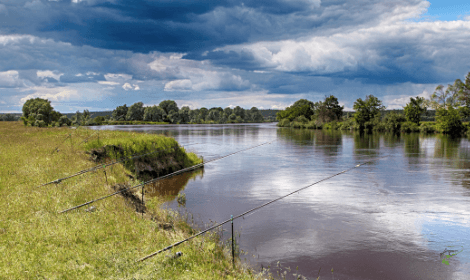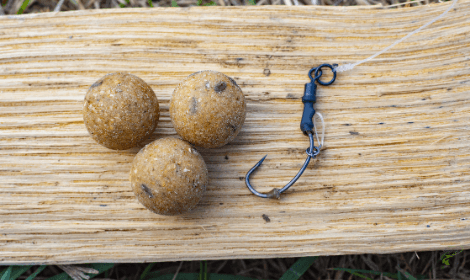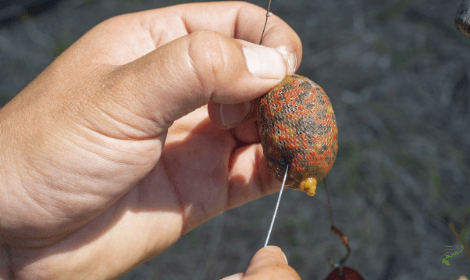
Although not welcomed as much in certain areas of the world carp fishing is extremely popular in others. In the areas where carp fishing reigns supreme, a good amount of the fishing can be done in rivers. Carp love the flowing, running water, and so should you.
If you are a beginning carp angler, knowing the ins and outs of the sport can be tricky. So, today we will break down a few aspects of river carp fishing and how you can elevate your game. Here is how to catch carp from a river!
Location is key

No matter what type of fishing you are doing, the location in which you fish is extremely important. Even more so when carp fishing in a river.
This is because your location will dictate how successful you could be. Carp have tendencies in certain areas, so knowing those tendencies will propel you to catching great fish. Here, we will break down some of these general trends, so you can follow along in your specific areas.
The first thing to look for in a river is the speed of the current. The faster the flow, the smaller the carp tend to be. This is because the larger carp have a hard time staying still, so they will migrate toward slower moving parts of the system. So, if you are chasing that trophy carp, you should find a portion of the river that is moving, but not too fast.
On the same page, these slower areas also tend to be deeper. Especially in the warm days of summer, carp love those deep, cool holes in the river. These two spots work in harmony to provide a the best spot to target.
Although you can’t really judge the flow and depth of a river on most maps, looking at a map beforehand can be super beneficial. You can look for cuts and bends, which is yet another hotspot to keep your eye out for. Plus, checking a map can help you find nearby parking, or camping areas.
So, the first step in even considering carp fishing on a river is finding and accessing a spot that has great potential to yield results. Without this step, the fish is already a step ahead.
Fish at the right time of year and day
Once you have a spot in mind, the next factor to consider is when to actually get out there to target these carp. Depending on your geographic location, these points will vary, but the generalities are very similar.
Like many areas of fishing, avoiding those really hot summer days is usually best. Fish go deeper, are more lethargic, and you will probably suffer as well. That is not to say you shouldn’t fish in the summer, but you need to plan your day logically. Go during dusk and dawn to take advantage of the slightly cooler temperatures.
The best season to go after carp on rivers is the spring. There is a sweet spot in every area where the weather is starting to turn for the better and the water is getting warmer. Finding that time when the water isn’t super cold and super hot can yield the best results.
In the spring, you can fish more hours while also taking advantage of the carps’ eating patterns. Still target those morning and evening times, but the hours in which the best results come expand.
Again, all of these points will vary slightly based on your location, but these tips transcend longitude and latitude in many cases.
Pre-bait the water

One of the best ways to increase your hookup probability while carp fishing is by pre-baiting the area you are planning to target.
The technique of priming the water is one that is used in all areas of carp fishing, not just on the river. That being said, don’t overlook this step when on the river.
https://bestofangling.com/pre-baiting-for-carp/ the water before trying to fish it increases your chances of hooking up tremendously. So, what is pre-baiting and how do I do it? Valid question, so let’s break it down.
Pre-baiting, is the act of putting carp food in the area you want to target hours, and even days, before actually fishing. It is important to not put too much or else the fish will be satisfied with the pre-bait and ignore the bait that matters: the one on your hook.
Ideally, between two days and 12 hours is a great time to prime your areas. If you are really confident in a certain spot, you can prime the area 3-5 times before fishing it for the first time.
You also want to pre-bait more than one area. If you only do a single spot, you are kind of locked into the spot in terms of pre-work, and if that one spot isn’t working out, you could be out of luck.
Popular pre-baits baits include smashed boilies, manufactured pellets, scented oils, sweetcorn, groundbaits and more. The key is to use these materials to target specific areas and not a broad area of water. This will turn simply feeding the fish to conditioning them to be in an accessible area.
Finally, be sure to check your local fishing laws and regulations. Although pre-baiting is super common for carp fishing, it can be banned or regulated in certain areas. So, check your local situation and plan accordingly.
Choose the Right Bait for the Job
Once you are all set to actually do some fishing, you need to know what you will use to lure these carp to bite. Picking the right bait and experimenting to a certain degree can make the process more enjoyable and successful.
One of the biggest spectrums of carp fishing is the bait. Choosing a bait can be a little overwhelming for beginners. So, let’s break down a few great options to get started with.

Firstly, there is maize, or sweetcorn. This is super popular in North America because of how prevalent it is. This isn’t to say that it does not work in other areas, because it definitely does. Some anglers even used pink or red coloured corn to really catch the carp’s eye.

There are also boilies. Boilies are essentially man-made balls that contain both natural ingredients and attractive additives. You can buy these at basically any carp fishing store there is, or you can easily make them yourself to save money. At first, buying them may be a better option, because manufacturers have done a really good job of crafting recipes that yield real results.
Finally, there is bread for fishing on the surface. Although there are a few more options, we are going to stick to the basics. This is one of the most classical baits in the history of carp fishing. Similarly to corn, bread is super cheap and can be purchased at any grocery store.
The downside of using bread is that it does not last long before having to be replaced. Because water breaks down the bread so quickly, you will have to constantly replace the bread. If you don’t mind that small hassle, bread is an excellent option that is cheap and proven to work.
Rig everything up to be thrown
There is a lot of back-end planning that has to be done, but the real fun starts when you can actually wet a line. The bait you are using should be rigged in an efficient way so that your chances of getting a bite that actually stays on the hook increases.

There are a number of carp rigs, and many of them do not depend on the body of water being fished. Firstly, there is the Solid PVA Rig. This is a go-to for a lot of carp anglers because it is simple, yet effective.
Another one of the staples in carp fishing is the Ronnie Rig. This is a super trusty setup, especially in the river. This rig uses a stiff hooklink, so the rig stays in perfect presentation the whole time.
Just about any normal, popular rig will do the trick in a slow-moving river. So, stick to what you already know and catch some fish!
Tips and tricks for Catching Carp From Rivers!
Finally, you get to throw a bait out there and do some real fishing. This is where the real fun begins. However, there are some little tips and tricks that can make your experience far more enjoyable and successful.
1. Invest in a quality net and mat
A majority of carp fishing is done from the shore, so investing in a landing mat and net that is of high quality is important. The bet should be big and deep so it can handle even the biggest of carp.
If you are new to carp fishing, you may be confused as to what a landing mat is. This is because they are not used in many other areas of fishing. Landing mats are used to get the carp onto the shore without harming them.
Carp have a very valuable slime coat that allows them to function normally. Throwing them on shore with no care will destroy this coat and injure the fish. A landing mat is slid under the fish and protects it from the shore. Especially in the U.K. and other areas around the world, these are commonplace and you will be scolded when fishing without one.
2. Use strike indicating rod holders
Because technology has evolved so much to help out anglers, a really cool advancement comes in the former of a rod holder. There are rod holders on the market that make noises and alert you when a fish is biting.
Since carp fishing is fairly passive in the sense that a lot of it happens with the bait sitting out there and you sitting on the shore waiting, having this alert system will ensure you don’t miss any bites.
3. Washing out boilies
One trick you can do very easily is known as washing out your boilies. Boilies are the little bait balls that are commonplace amongst carp presentations.
Washing out the boilies is the act of soaking them in water days before you plan on using them. This fades the coloring of the boilie and transforms the presentation to represent old, safe bait. So, when the carp is swimming by and sees this faded boilie sitting on the bottom, they are more confident in biting because it does not seem like the traditional fishing presentation.
4. Use feed deposits when you can
In certain areas, this technique is not allowed, but depending on where you are, you can use feed deposits. Feed deposits are bags that are filled with carp feed that are put in the water, near your area of targeting.
This is another way of priming the water in the sense that more feed will increase interest in the area. There are specific bags that are made for this purpose. One of the main kinds of bags is a mesh that allows for the bait to be released into the water as the bait breaks down.
Again, consult your local laws and regulations to see if feed deposit bags can be used in your area.
5. Be patient
One aspect that is super prevalent in carp fishing is patience. Patience is a lesson taught in all areas of fishing, but carp fishing on rivers specifically really hammers this point home. That is because you probably aren’t actively casting and retrieving the bait. There is a lot of cast it out there, set it up on the bank, and sit and wait. There is nothing wrong with this, but it does require a higher level of patience.
That’s All!
Hopefully, you now have a far better idea of how to catch carp from a river. Although not much changes between the water bodies, river fishing does call for some specific strategies. So, take in these points and apply them to the next time you are out on the river targeting carp!

